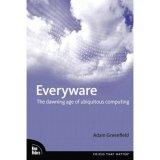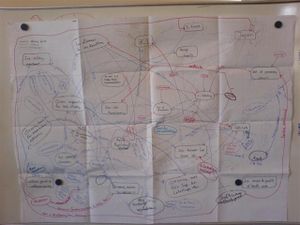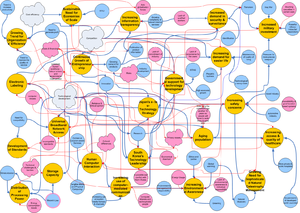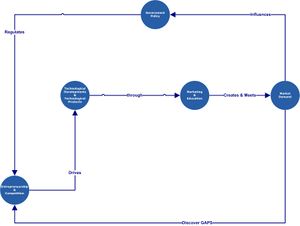The Future of Ubiquitous computing in 2025
ICT in Business 2007 @ Leiden University School of Management
Team Composition
Client Question
- Will the average citizen of a developed nation in 2025 enjoy an enhanced sense of personal freedom as a result of information processing in everyday life?
- How about the reality of personal freedom, as opposed to that person's subjective assessment?
- And how about the average citizen of a less developed nation?
Adam Greenfield http://www.v-2.org/
Introduction
u·biq·ui·tous [yoo-bik-wi-tuhs]
–adjective
existing or being everywhere, esp. at the same time; omnipresent: 'ubiquitous fog; ubiquitous little ants.
(Dictionary.com entry)
Ubiquitous computing (ubicomp) integrates computation into the environment, rather than having computers which are distinct objects. Other terms for ubiquitous computing include pervasive computing, calm technology, things that think, everyware, and more recently, pervasive Internet. Promoters of this idea hope that embedding computation into the environment and everyday objects would enable people to interact with information-processing devices more naturally and casually than they currently do, and in ways that suit whatever location or context they find themselves in.
Ubicomp's central aim has been invisibility, meaning that one does not need to continually rationalize one's use of a ubicomp system. Having learnt about its use sufficiently well, one ceases to be aware of it. It is "literally visible, effectively invisible" in the same way that a skilled carpenter engaged in his work might use a hammer without consciously planning each swing. Similarly, when you look at a street sign, you absorb its information without consciously performing the act of reading.
Ubicomputing is considered by some as the next great wave in IT development. Currently we see a wide range of research and experimental projects which are discovering the potentials of ubiquitous computing. In the related articles and videos sections below some of these experimental projects are highlighted. Ubiquitous computing is also currently being implemented into urban areas all over the developed world. For example: the newly introduced 'top-up' cards in the Dutch public transport sector, a "media table" in the lobby of New York's Asia Society, New York hotel rooms which 'remember' the preferred environmental settings (room temperature, lining up entertainment options, and loading up frequently dialed numbers) of their high margin frequent guests, and numerous new developments of ubiquitous computing embedded into the environment of many cars (features such as the Volvo blind-spot information system and personalized driver settings in many cars today).
Synonyms for Ubiquitous computing:
- pervasive computing
- calm technology
- things that think
- everyware
- pervasive Internet
- physical computing
- tangible media
Possible areas of development may be: energy efficient architectures, ubiquitous computing in housing, lightweight ad-hoc networks and their applications (context-aware computing), and sensor networks including applications.
The Driving Forces
Economical
- Continous Growth of Entrepreneurship
- Growing Trend for Organizations' Efficiency
- Increasing Information transparency
- Sustainable Need for Economies of Scale
Environmental
Political
- Increased demand in security & surveillance
- Increased military investment
- Governmental support for technology development
- Japan's e- to u-Technology Strategy
- South Korea's Technology Leadership
Social
- Aging population
- Increasing access & quality of healthcare
- Increasing demand for easier life
- Increasing safety concerns
- Increasing use of computer-mediated communication
Technological
- Electronic Labeling
- Human Computer Interaction
- Universal Broadband Network Access
- Distribution of Processing Power
- Storage Capacity
- Development of Standards
System Diagrams
Our group met for several days to brainstorm about how the driving forces of ubiquitous computing connect with each other and created a system. During the building of the system's diagram, we added and tweaked some driving forces. This version lead to the Feedback loop which is displayed below. We see that the feedback loop is a high level perspective of the environment of driving forces. The driving forces we identified earlier, seem to be the main generic driving forces behind the development of the ubicomputing. The third level of depth of our system are the enablers and inhibitors. The diagrams below show the different levels!
Brainstorm version - System's Diagram
System Design with driving forces, enablers and inhibitors
Final - Feedback Loop Diagram
Scenarios
Research
Research Agenda
Analysis of the book 'Everyware' on Ubiquitous Computing
Research CeBIT 2007 - Hannover
We went to CeBit 2007 in Hannover to look at what new developments in IT and Ubiquitous computing there are. This is what we found:
- Bathroom mirror with an integrated LCD [1]
- Another bathroom mirror [2]
- Bathroom mirror video [3]
- "Wallscreen" [4]
- Digital frame [5]
- Digital frames [6]
- Digital drawing board [7]
- HCI Development - Controlling interfaces with your eyes [8]
- Clothing/"Lederhosen" with music players, phones, body sensors build in [9] [10]
- Viviane Reding's speech on ubicomp during the first day of CeBIT 2007
Experts
- Marc Weiser
- Adam Greenfield
- Teruyasu Murakami
- Akihisa Fujinuma
- Ichire Morimoto
- Hiroyuki Makamura
- Friedemann Mattern
- Takeshi Nakagawa
- Hideaki Nakamoto
- Masatoshi Komeichi
- Tadashi Tsuji
- Toshitada Nagumo
- Hisao Nakajima
- Yasutake Okano
Related Articles
- The Disappearing Computer by Bill Gates. link
- A Digital Life link
- Original website of Marc Weiser. link
- Techware. link
- Wearable computing Lab ET Zurich. link
- Social, Economic, and Ethical Implications of Ambient Intelligence and Ubiquitous Computing. Link
- Wireless Future: Ubiquitous Computing Link
- Living in a World of Smart Everyday Objects - Social, Economic, and Ethical Implications Link
- Ambient Intelligence: Changing Forms of Human-Computer Interaction and their Social Implications Link
- What Does Ubiquitous Computing Mean For Teaching and Learning? Link
- EU Report: Shaping Europe’s Future Through ICT Link
- Toward Computer-Supported Ubiquitous Language-Learning Link
- Supporting Classroom Activities toward the Ubiquitous Learning Environment Link
Videos
- Amigo: The Intelligent Home Network link
- CES 2007 - Microsoft Keynotelink
- HCI with eye-motion detection link
- Intelligent Drawings (for kids) link
- Multi-Touch Experience link
- Minority Report becomes reality link
- Ubicomputing Fashion South Korea link
- Wearable Computing Systems link
Books
 The dawning age of Ubiquitous Computing by Adam Greenfield
The dawning age of Ubiquitous Computing by Adam Greenfield
Rating & Comments
<pagerating from="Poor" to="Good" category="Scenario"> Rate this page</pagerating>


